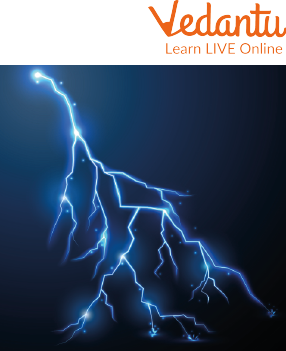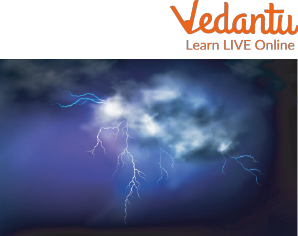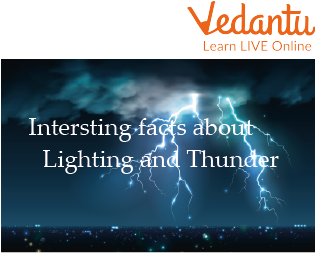




Overview of the Lightning and Thunderstorm
Every small kid likes the rain. They love to dance in the rain and sail their paper boat, and the most enjoyable part for them is to eat fritters in the rain. But, have you ever heard the booming sound while raining: it's Thunder. It sounds so scary, isn't it? But don't worry that scary sound doesn't hurt anyone, but the same can't be said for lightning because it can kill a person.
So now in this article we will learn about thunder and will understand about lightning, will discuss many thunderstorm facts and what are the causes of thunder and lightning. So now let's get started and learn about the thunder and the lighting.

Learning About Lightning And Thunder
What is the Lightning?
During rain have you seen the huge and bright strike of light if yes then do you know what's that called? It's lightning. Lightning is a very powerful burst of electricity which happens very quickly. It's a natural electrical discharge which is of very high voltage and it happens for a very short period. Its temperature is approximately 54,000° Fahrenheit.
Lightning can happen between the clouds or inside the clouds and even from clouds to the earth. Lightning makes the air very hot and the air which suddenly gets heated expands very quickly. Pulmonology is the study of lightning. And the fear of lightning is seen in many people and that is called astraphobia.
What is Thunder?
It's caused by lightning. It's the loud and horrible sound that we hear after we see the bright flash of light. Thunder sound is produced by lightning. Let's see how it happens. So, When the lightning bolt travels from the clouds to the ground it opens up a little hole in the air which is called a channel. And Once the light is gone then the air collapses back which creates a very horrible sound wave that we hear as thunder.
What Comes First? Thunder or Lightning?
Lightning and thunder occur at the same time lightning strokes displace a small volume of the air and when the stroke is completed the air comes back into space. That's where the crack of thunder occurred.
So if they both happen at the same time then why it happens that we can always hear the sound of thunder after we have seen the stroke of light that's because
The speed of light is 299792458 m/s
And the speed of sound is 343 m/s. So we can see that light travels faster than sound. That's Why we always see the lightning first and after a few seconds, we hear the thunder.
Just remember one thing and that's if the air is warmer then faster the sound of thunder will travel and if the air is cool then slower the sound of thunder will travel.

Lightning
Science Behind the Weather
We always stay curious to know the science behind the weather, we always want to know why thunder and lightning happen and what the causes of lightning and thunder are, so now let's clear it up too.
So why do lightning and thunder happen? And it happens because the very small bits of ice particles and the water droplets which are inside the clouds, bump into each other which creates a positive electric charge. And as the opposite attracts each other that's why those positive charges in the thunder get attracted by the negative charges which are below the clouds and then the sparkle big flash of lightning generates very fastly and equalises the negative-positive charge which is in the atmosphere until the opposite charges are set up again. So in this way lightning and thunder happen.
Facts About Lightning and Thunder

Facts About Thunder And Lightning
Do you know every year, on average 2,40,000 people are injured by a lightning strike every year.
The average thickness of the bolt is around 1-2 inches.
The electricity in the lightning: never travels from the cloud to the ground it travels from the ground to up.
The temperature of the lightning is more than 5 times the temperature of the sun.
The place where the most lightning strikes happen is Lake Maracaibo in Venezuela. It's the place on earth which receives the most lightning strikes, on average 40,000 lightning strikes in one night.
Summary
So in this article, we learned about lightning and thunder. We learnt about what lightning is, what thunder is, what causes lightning and thunder i.e what’s the science behind that weather, we discussed some interesting fun facts about lightning about thunder, and had learned about the safety tips which we take when it’s lightning and thunder because it’s very dangerous and can give some serious harm that’s why it’s important to stay safe from lightning and thunder.
So after reading this we have a little bit of understanding of lightning also. We learned how dangerous it is and how we can protect ourselves from it. With this we have come to an end of our article and we hope you enjoyed reading the same. In case of any other doubts, feel free to ask in the comments.
FAQs on Lightning and Thunderstorm
1. What is the basic difference between a thunderstorm and lightning?
A thunderstorm is a complete weather event characterised by the presence of lightning and its acoustic effect, thunder, often accompanied by strong winds and heavy rain. Lightning, on the other hand, is a specific component of a thunderstorm; it is the powerful, natural electrostatic discharge (a giant spark) that occurs when there is a large imbalance of electrical charge within clouds, between clouds, or between a cloud and the ground.
2. What causes thunderstorms and lightning to occur?
Thunderstorms are caused by the rapid upward movement of warm, moist air. As this air rises, it cools and condenses, forming tall cumulonimbus clouds. Inside these clouds, friction between rising ice crystals and falling water droplets separates electrical charges. Positive charges typically accumulate at the top of the cloud, and negative charges at the bottom. When this charge separation becomes too great, the atmosphere can no longer insulate it, resulting in a massive electrical discharge, which we see as lightning.
3. Why do you always see lightning before you hear thunder?
You see lightning before hearing thunder because light travels significantly faster than sound. The speed of light is approximately 299,792 kilometres per second, so the flash of lightning reaches your eyes almost instantly. The speed of sound is much slower, around 343 metres per second. Therefore, the sound wave (thunder) created by the lightning strike takes several seconds to travel the same distance to reach your ears.
4. Is it possible to have thunder without lightning?
No, it is not possible to have thunder without lightning. Thunder is the sound directly created by a lightning strike. The intense heat of a lightning bolt rapidly expands the surrounding air, creating a sonic shockwave that we hear as thunder. While you might sometimes hear thunder without seeing a flash, it simply means the lightning occurred too far away to be seen, was obscured by clouds (in-cloud lightning), or happened beyond the horizon.
5. What are the essential safety measures to follow during a thunderstorm?
Following safety rules is crucial during a thunderstorm. The safest place is inside a sturdy, enclosed building. If you are caught outside, remember these key points:
Seek shelter in a hard-topped car or a low-lying area. Avoid open fields and tall, isolated objects like trees or poles.
Stay away from water bodies like ponds, lakes, and swimming pools, as water is an excellent conductor of electricity.
If you are in a group, spread out to reduce the risk of multiple injuries from a single strike.
Avoid contact with metal objects like fences, gates, or bleachers.
6. What specific precautions should be taken if you are inside a house during a thunderstorm?
Even inside a house, you should take precautions. Lightning can travel through a building's electrical wiring, plumbing, and any metal wires or bars. Therefore, you should avoid using corded phones, computers, and other electrical appliances. It is also wise to stay away from plumbing, so do not take a shower, wash dishes, or wash your hands during a thunderstorm.
7. Can lightning strike the same place more than once?
Yes, absolutely. This is a common myth. Lightning can and frequently does strike the same place multiple times, especially if it is a tall, pointed, and isolated object. For example, famous tall structures like the Empire State Building in New York City are struck by lightning dozens of times each year.
8. What is a lightning conductor and how does it protect a building?
A lightning conductor is a safety device used to protect buildings from lightning strikes. It consists of a metal rod, thicker than the building, that is installed at the highest point of the structure. This rod is connected to a thick copper strip that runs down the side of the building and is buried deep in the ground. It works by providing a low-resistance path for the lightning's electrical current to follow, guiding the charge safely to the ground (a process called earthing). This prevents the current from passing through the building itself, which could cause fire or structural damage.
9. How is the process of charging by rubbing related to the formation of lightning?
The process of charging by rubbing, or static electricity, is the fundamental principle behind lightning, but on a much larger scale. When you rub a plastic ruler on your hair, electrons are transferred, and the ruler becomes charged, allowing it to attract small pieces of paper. Similarly, inside a storm cloud, the vigorous movement and friction between rising water droplets and falling ice crystals cause a massive transfer of charge. This separation creates huge regions of positive and negative charge, leading to the powerful electrical discharge we know as lightning.









